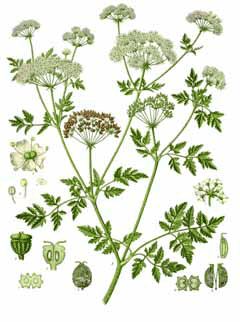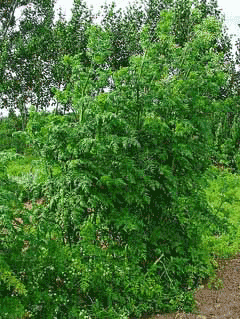 |
|
https://edibleplants.org/ |
 |
|
Translate this page:
Summary
Physical Characteristics

 Conium maculatum is a BIENNIAL growing to 2 m (6ft) by 1 m (3ft 3in).
Conium maculatum is a BIENNIAL growing to 2 m (6ft) by 1 m (3ft 3in).
See above for USDA hardiness. It is hardy to UK zone 5 and is not frost tender. It is in flower from June to July. The species is hermaphrodite (has both male and female organs) and is pollinated by Insects. The plant is self-fertile.
Suitable for: light (sandy), medium (loamy) and heavy (clay) soils. Suitable pH: mildly acid, neutral and basic (mildly alkaline) soils. It can grow in semi-shade (light woodland) or no shade. It prefers moist soil.
UK Hardiness Map
US Hardiness Map
Synonyms
Plant Habitats
Woodland Garden Dappled Shade; Shady Edge;
Edible Uses
Edible Parts: Leaves
Edible Uses:
Leaves - cooked[105]. Although toxic, plants found in the south of England are comparatively harmless and the leaves are used as a pot-herb[2]. They can also be dried for later use. The toxic principle is said to be destroyed by thorough cooking or drying[4, 100]. Caution is advised, especially on the remarks about plants in southern England[K]. See the notes above on toxicity.
References More on Edible Uses
Medicinal Uses
Plants For A Future can not take any responsibility for any adverse effects from the use of plants. Always seek advice from a professional before using a plant medicinally.
Analgesic Antirheumatic Antispasmodic Cancer Emetic Epilepsy Galactofuge Homeopathy
Sedative
Hemlock is a very poisonous plant that has a long history of medicinal use, though it is very rarely used in modern herbalism[238, 254]. It is a narcotic plant that sedates and relieves pain[238]. The plant contains coniine, an extremely toxic substance that can also cause congenital defects[254]. The whole plant is analgesic, antispasmodic, emetic, galactofuge and sedative[4, 7, 9, 21, 213, 222]. It is a traditional folk treatment for cancer[222] and was formerly widely used internally in very small doses to treat a variety of complaints including tumours, epilepsy, whooping cough, rabies and as an antidote to strychnine poisoning[232, 254]. It is still used externally, usually in ointments and oils, in the treatment of mastitis, malignant tumours (especially breast cancer) anal fissure and haemorrhoids[238]. The leaves and stems should be harvested when the first fruits are forming, since they are then at their most active medicinally[4]. The fruits are gathered either when fully ripe, or before they turn from green to yellow, and are then dried[4]. Because of the extremely toxic nature of this herb, it is seldom employed nowadays[232]. Use with extreme caution and only under the guidance of a qualified practitioner[21, 238]. See also the notes above on toxicity. A homeopathic remedy is prepared from a tincture of the fresh plant, harvested when in flower[232]. It is used for treating complaints such as dizziness, coughs, insomnia, exhaustion[232], arteriosclerosis and prostate problems[7].
References More on Medicinal Uses
The Bookshop: Edible Plant Books
Our Latest books on Perennial Plants For Food Forests and Permaculture Gardens in paperback or digital formats.

Edible Tropical Plants
Food Forest Plants for Hotter Conditions: 250+ Plants For Tropical Food Forests & Permaculture Gardens.
More

Edible Temperate Plants
Plants for Your Food Forest: 500 Plants for Temperate Food Forests & Permaculture Gardens.
More

More Books
PFAF have eight books available in paperback and digital formats. Browse the shop for more information.
Shop Now
Other Uses
References More on Other Uses
Cultivation details
A fairly common weed in Britain, it succeeds in most soils in sun or light shade and avoids acid soils in the wild. It prefers a damp rich soil[238]. This is the plant that Socrates is said to have used to kill himself, though this is probably an error[207]. It requires a large dose if it is to be lethal (this contradicts with the notes above on toxicity[K]), and death from this plant can be very painful whilst Socrates is said to have died without pain[207]. Another report says that poisonous doses cause paralysis, which starts at the feet and moves up the body. There is no pain, the mind remains clear and lucid until death, which is caused by asphyxia when paralysis reaches the chest[232]. The whole plant has a foetid smell[7].
References Carbon Farming Information and Carbon Sequestration Information
Temperature Converter
Type a value in the Celsius field to convert the value to Fahrenheit:
Fahrenheit:
The PFAF Bookshop
Plants For A Future have a number of books available in paperback and digital form. Book titles include Edible Plants, Edible Perennials, Edible Trees,Edible Shrubs, Woodland Gardening, and Temperate Food Forest Plants. Our new book is Food Forest Plants For Hotter Conditions (Tropical and Sub-Tropical).
Shop Now
Plant Propagation
Seed - best sown in situ as soon as it is ripe in the late summer. It usually germinates in the autumn.
Other Names
If available other names are mentioned here
beaver poison; carrot-fern; fool's-parsley; hemlock; herb bennet; kecksies; kex; musquash root; poison parsley; spotted corobane; spotted-hemlock; spotted-parsley.
Spanish: encaje cimarrón; panalillo; perejil de chucho; perejil de monte; zanahoria silvestre.
French: cigue maculee; cigue tache; cigue tachetee; grande ciguë
Chinese: du shen.
Brazil: cicuta; funcho-selvagem.
Germany: Gefleckter Schierling.
Guatemala: perejil de chucho; perejil de monte.
Italy: cicuta maggiore.
Netherlands: gevlekte scheerling.
Sweden: odört.
Native Range
TEMPERATE ASIA: Afghanistan, Iran, Iraq, Israel, Jordan, Lebanon, Syria, Turkey, Russian Federation-Ciscaucasia (Ciscaucasia), Armenia, Azerbaijan, Georgia, Russian Federation (Dagestan), Russian Federation-Western Siberia (Western Siberia), Kazakhstan, Kyrgyzstan, Tajikistan, Turkmenistan, Uzbekistan TROPICAL ASIA: India (Jammu and Kashmir), Pakistan (north) EUROPE: Denmark, Finland, United Kingdom, Ireland, Norway, Sweden, Austria, Belgium, Switzerland, Czech Republic, Germany, Hungary, Netherlands, Poland, Slovakia, Belarus, Estonia, Lithuania, Latvia, Moldova, Ukraine, Albania, Bulgaria, Bosnia and Herzegovina, Greece, Italy, North Macedonia, Montenegro, Romania, Serbia, Slovenia, Spain, France, Portugal AFRICA: Algeria, Morocco, Tunisia, Ethiopia
Weed Potential
Right plant wrong place. We are currently updating this section.
Please note that a plant may be invasive in one area but may not in your area so it's worth checking.
This plant can be weedy or invasive. Considered an invasive species in 12 U.S. states. Competes with pasture and crops and encroaches on native vegetation, while posing a serious health hazard to virtually all livestock, and humans.
Conservation Status
IUCN Red List of Threatened Plants Status : This taxon has not yet been assessed.

Growth: S = slow M = medium F = fast. Soil: L = light (sandy) M = medium H = heavy (clay). pH: A = acid N = neutral B = basic (alkaline). Shade: F = full shade S = semi-shade N = no shade. Moisture: D = dry M = Moist We = wet Wa = water.
Now available:
Food Forest Plants for Mediterranean Conditions
350+ Perennial Plants For Mediterranean and Drier Food Forests and Permaculture Gardens.
[Paperback and eBook]
This is the third in Plants For A Future's series of plant guides for food forests tailored to
specific climate zones. Following volumes on temperate and tropical ecosystems, this book focuses
on species suited to Mediterranean conditions—regions with hot, dry summers and cool, wet winters,
often facing the added challenge of climate change.
Read More
Expert comment
Author
L.
Botanical References
17
Links / References
For a list of references used on this page please go here
Readers comment